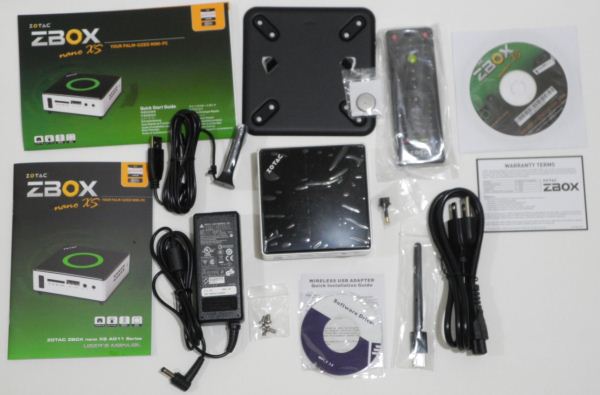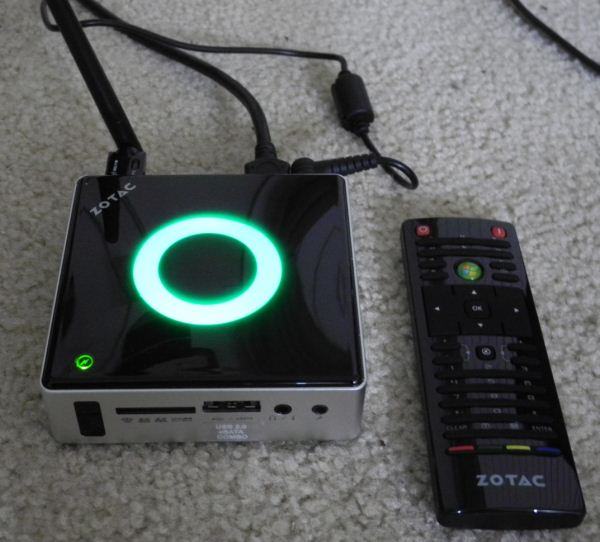Zotac ZBOX Nano XS AD11 Plus: Redefining the Small Form Factor PC
by Ganesh T S on April 11, 2012 5:30 PM EST- Posted in
- Home Theater
- ZOTAC
- Fusion
- HTPC
The ZBOX comes in a small package, about the size one would expect for a mid-range graphics card. In making up for the small size of the PC, Zotac has put in all sorts of add-on peripherals into the package. The external PSU is rated for 65 W. Apart from the main unit, the setup guides, user manuals and driver CDs, the package contained the following:
- VESA mounting plate with mounting screws
- MCE remote with 2 CR2032 batteries
- 65W (19V at 3.42A) AC - DC adaptor
- USB 2.0 based Wi-Fi (150 Mbps 802.11n) adaptor
- mini-Optical SPDIF adaptor
- USB 2.0 based extensible IR receiver (allows users to utilize the MCE remote even when the ZBOX is VESA mounted)
The main unit has a sleek rounded finish and is definitely aesthetically pleasing. The various external features of the unit have already been tabulated in the previous section. The gallery below has some photos of the unit.
The underside of the unit can be easily removed by unscrewing the four rubber risers. This gives access to the SO-DIMM as well as the mSATA slot. These are the user replaceable components. After voiding the warranty, it is possible to take a look at the other side of the board. It is quite surprising that Zotac has managed to put a fan on top of the board in such a small system. Given the space constraints, the fan is indeed short in diameter. When the system isn't being stressed much, the fan is pretty quiet. However, once the fan starts to increase the RPM, the noise dampening is not effective at all. While I would have preferred a fanless system, I do see that the target market for this PC might include people who don't understand the necessity to keep a passively cooled system in a well ventilated location.
After putting the system back together, I proceeded to boot up the system. The BIOS is quite basic, and very similar to what Ian saw in the Zotac Fusion350-A-E review except for a custom background. My main gripe with the BIOS is that there is no way for the users to set the amount of memory to keep allocated to the integrated GPU. It is set to a very inflexible 384 MB.
Once past the BIOS, I went ahead and installed Windows 7 Ultimate x64 off an USB flash drive. The install went smooth, albeit not as fast I would have wanted for a SSD based system. After installation, I found that a number of peripherals were not working (including the Ethernet and the Wi-Fi). All the drivers to be installed were on a couple of CDs, and this was a system with no optical drive. I had to hunt down another machine with an optical drive and then copy over the CD's contents onto a flash drive to proceed with the installation. After this stage, Windows took care of updating itself. It is really irritating to see companies shipping units without optical drives, but still supply drivers on a CD.
The Zotac ZBOX Nano XS AD11 Plus in Operation
(Note that the bright green ring can be turned off in the BIOS)
SSDs are meant to get things done fast on a machine. Reduction in boot time is one of the purported advantages. However, on the ZBOX unit, a Win7 SP1 clean install took around 31 seconds to boot. This is nothing to write home about. In the next section, we will take a look at the general performance metrics.
























43 Comments
View All Comments
NerdMan - Friday, April 13, 2012 - link
I mean, the picture quality in general has been lackluster.This is poor as well:
http://images.anandtech.com/galleries/1868/Large%2...
GullLars - Friday, April 13, 2012 - link
Like stated in the article, i too find including drivers on a CD on a system without an optical drive is a major FAIL.A quick google search found 4GB mini/micro/pico size usb drives cost $5-6, that should be enough for drivers with good margin, and compared to the total cost of the system at $360 is under 2%.
I have one major critizism for the system though, they only populate one RAM channel. The integrated GPU on Bobcat and Llano like memory bandwidth, so the couple of $ needed for an extra memory slot and DIMM would IMHO be an obvious better sollution.
ProDigit - Sunday, April 22, 2012 - link
Some devices need a high resolution.I would like to have known if this device is capable of outputting to 640x480 or an 800x480 output.?
It is needed for entry LED projectors.